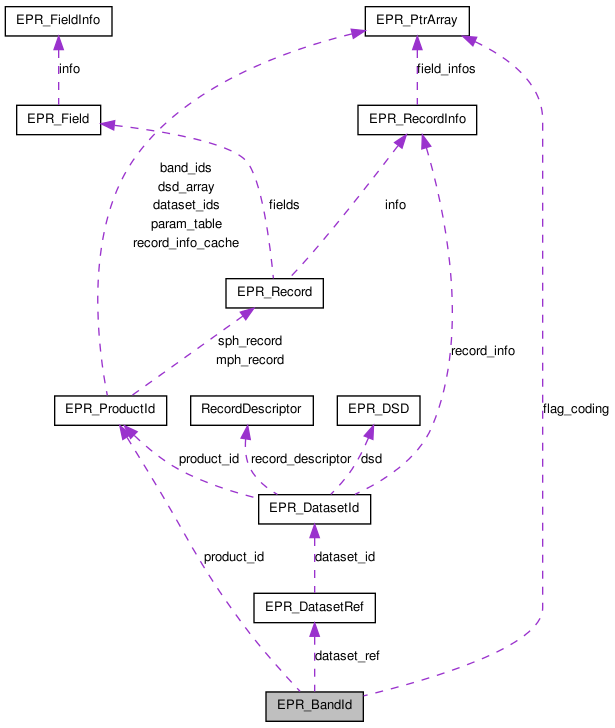#include <epr_api.h>

Public Attributes | |
| EPR_Magic | magic |
| EPR_SProductId * | product_id |
| char * | band_name |
| int | spectr_band_index |
| EPR_SDatasetRef | dataset_ref |
| EPR_ESampleModel | sample_model |
| EPR_EDataTypeId | data_type |
| EPR_EScalingMethod | scaling_method |
| float | scaling_offset |
| float | scaling_factor |
| char * | bm_expr |
| EPR_SPtrArray * | flag_coding |
| char * | unit |
| char * | description |
| boolean | lines_mirrored |
Detailed Description
The EPR_BandId structure contains information about a band within an ENVISAT product file which has been opened with the epr_open_product() API function.
A new EPR_BandId instance can be obtained with the epr_get_band_id() API function.
- See also:
- epr_open_product
- epr_get_band_id
Member Data Documentation
| char* EPR_BandId::band_name |
The name as presented to the user in a band selection dialog (also known as spectral subset)
| char* EPR_BandId::bm_expr |
A bit-mask expression used to filter valid pixels. All others are set to zero.
| EPR_EDataTypeId EPR_BandId::data_type |
The data type of the band's pixel values. Possible values are:
<ld> * --> the datatype remains unchanged. UChar --> 8-bit unsigned integer ULong --> 32-bit unsigned integer Float --> 32-bit IEEE floating point </ld>
Referenced by MerisFileData::read_data().
The reference of the source dataset containing the raw data used to create the band's pixel values. The external format used in the DDDB is <MDS-name>.<field>, where <field> is a one-based index (field=1 corresponds to the first field)
Referenced by MerisFileData::read_data().
| char* EPR_BandId::description |
A short description of the band's contents
The flag coding is a list of EPR_SFlag instances. It determines each of the flags used in this band (= flags dataset). Each flag has a name, a bit-index and a description.
| boolean EPR_BandId::lines_mirrored |
If true (=1) lines will be mirrored (flipped) after read into a raster in order to ensure a pixel ordering in raster X direction from WEST to EAST.
| EPR_Magic EPR_BandId::magic |
The magic number for this structure. IMPORTANT: This must always be the first member of this structure.
The ID of the product to which this band belongs to.
| EPR_ESampleModel EPR_BandId::sample_model |
The sample model operation applied to the source dataset for getting the correct samples from the MDS (e.g. MERIS L2). Possible values are * --> no operation (direct copy) 1OF2 --> first byte of 2-byte interleaved MDS 2OF2 --> second byte of 2-byte interleaved MDS 0123 --> combine 3-bytes interleaved to 4-byte integer
Referenced by MerisFileData::read_data().
The scaling factor. Possible values are: * --> no factor provided (implies scaling_method=*) const. --> a floating point constant <GADS>.<field>[.<field2>] --> value is provided in global annotation dataset with name <GADS> in field <field>. Optionally a second element index for multiple-element fields can be given too
| EPR_EScalingMethod EPR_BandId::scaling_method |
The scaling method which must be applied to the raw source data in order to get the 'real' pixel values in geo-physical units. Possible values are: * --> no scaling applied Linear_Scale --> linear scaling applied: y = offset + scale * x Log_Scale --> logarithmic scaling applied: y = log10(offset + scale * x)
The scaling offset. Possible values are: * --> no offset provided (implies scaling_method=*) <const.> --> a floating point constant <GADS>.<field>[.<field2>] --> value is provided in global annotation dataset with name <GADS> in field <field>. Optionally a second element index for multiple-element fields can be given too
The (zero-based) spectral band index. -1 if this is not a spectral band.
| char* EPR_BandId::unit |
The geophysical unit for the band's pixel values
The documentation for this struct was generated from the following file:
- /home/pascal/depot/filedata/src/epr/epr_api.h
 1.7.1
1.7.1